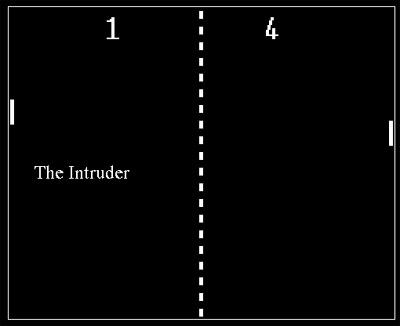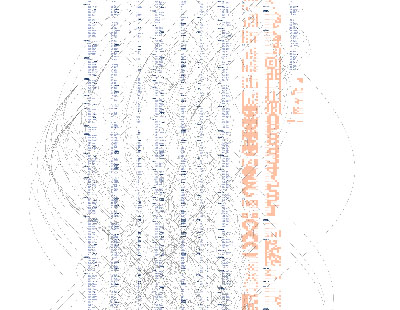 |
[December 1st 2005]

The classic Pong game used in Natalie Bookchin's art game The Intruder.
Art Games
An introduction
Art Games is becoming a genre. Kristine Ploug gives an introduction.
Computer Games
The first computer game, Spacewar, was born at Massachusetts Institute of Technology in 1961. Then an era of Pong and subsequently more advanced arcade games occurred. Then came the consoles - both for use at home and the handheld ones, the latest arrival being the PlayStation Portable, the PSP. We now live in a time of increasingly advanced 3D games for different platforms.
The computer game industry is thriving. It is making more money than the movie industry, and games are showing up in more and more contexts. A lot of box office hits are accompanied by games (Harry Potter, Lord of the Ring .) and with the new movie King Kong the game is even launched before the movie.
Games are virtually everywhere. Politicians have games on their websites as part of their election campaigns. Kids are increasingly learning through games. Games are everywhere and it is believed that they will move into even more places in the future.
Introducing: Art Games
But enough about games as such. As a small subcategory of computer games you find Art Games. They are made by artists as pieces of art. Some have ulterior motives, mainly political, others are merely a playful piece of interaction with the user.
What makes them art and not just games? For some, the fact that they were made as art, for others the fact that they are exhibited as art - it can all be boiled down to the intention behind them, originating from either the curator or the artist. An example of an art game is Samorost, which was made as a quirky design project, rather than art, but has been seen by several curators as art.

From Samorost by Jakub Dvorsky.

In Trigger Happy by Thompson and Craighead, the player shoots down text. The aesthetic comes from Space Invaders.
In the right context, commercial games can be perceived as art as well. There is no doubt that a lot of talent, skill and will goes into producing the commercial games. And although they are not produced as art, but merely as entertainment, we see a lot of examples of things that were not meant as art being exhibited in an art context. Benjamin Fry's Valence is an example of a tool with a concrete purpose that has been exhibited as art and thus becomes art. And what commercial computer games are lacking in artistic thought, they undoubtedly possess in craft and an impressive use of the technology. Another discussion is, whether it is good art or bad and I must admit that I find most commercial games inferior as art. And not least: I find the discussion boring. So, back to art games.

Alison Mealey: Unrealart. Art made in the Unreal engine.
Art Games: A Few Characteristics
It seems that there are a few defining characteristics to art games. Tiffany Holmes gives a definition of art games in her article Arcade Classics Spawn Art? Current Trends in the Art Game Genre (2003). Her definition goes: " . art games contain two of the following: a defined way to win or experience success in a mental challenge, passage through a series of levels (that may or may not be hierarchical), or a central character or icon which represents the player."
I can add that in most cases the art games are neither addictive nor meant to be played over and over, but merely shorter comments. Most art games are playable online, they are usually made for a PC and usually meant for a single player. The games always have interaction, but this interaction doesn't always have an effect on what goes on in the game. In Natalie Bookchin's game The Intruder, the many different games played by the user are merely a way to keep the user busy, while listening to a story by Jorge Luis Borges.

Tom Bett's QQQ - a modification of the Quake game.

Gonzalo Frasca's September 12 - a political game.
Art games can roughly be divided into two groups: political games and aesthetic games. A clear political game is Gonzalo Frasca's September 12. Another division can be made between the made-from-scratch games and the art mods - modifications of existing games. A lot of the big games allow modding, where you can create your own version of the game. A category related to the art mods is Machinima (a short form of mechanical animation ), pre-recorded and often edited movies made in a game by many users coordinating their characters. At this year's Ars Electronica, they showed several Machinimas.

Machinima: A music video called I got my G mail made in the computer game Sims.
Several art games don't quite fit the categories, but are using elements from the game format in the artwork. Computer based art has the advantage of using a media that is truly contemporary and integrated in our everyday life - at Artificial, we believe that it is the natural art of our times. Reacting to - and using the language of - computer games is an obvious development.
In a recent interview with Artificial, the creator behind Samorost, Jakub Dvorsky, said when asked what the game genre has to offer: "It's obvious - games are so popular because when you are playing games you are not only a viewer but also a player - you can influence what is happening in the game. So the artist creating an 'artistic game' can count on it and involve some new ideas in it, which couldn't work in movies, literature or in paintings. In my opinion, the game genre brings a whole new universe of possibilities for artists."

From Ben Fry's Distellamap - drawings of code from old game cartridges. On the picture above it is the old Pac Man game.
With games being the art form of the future, it is quite funny, though, that a lot of artist s use the retro-aesthetics of the 70's and 80's games. The pixelated spaceship of Space Invaders is seen several places and so is Pac Man and Super Mario. It is quite rare to see an art game looking like a slick 3D photo - like Hitman. There might be several reasons for this. The nostalgic, iconic, retro-aesthetics might be what the artists are after, but it might also be because the 3D environment is simply not feasible. The computer industry spends years and lots of money on their production and resembling that on a artist budget might not be possible.

Carlo Zanni's Average Shoveler lends its aesthetic from the 80's Leisure Suit Larry game.
To be Continued .
Over the next month, Artificial will bring you various articles about art games. Stay tuned. And in case you are still wondering: Computer games are for grown-ups - we have statistic material to back us on this one.
More?
For theoretical readings about art games:
Pippa Stalker:
http://www.selectparks.net/dl/PippaStalker_GamingInArt.pdf
Tiffany Holmes:
"Arcade Classics Spawn Art? Current Trends in the Art Game Genre"
Rebecca Cannon:
Introduction to Artistic Computer Game Modification.
Tilman Baumgärtel:
On a Number of Aspects of Artistic Computer Games
Anne-Marie Schleiner et al:
Theme issue of the online journal Switch: Games
Exhibitions:
Computer Games by Artists (Curated by Tilman Baumgärtel)
Trigger (Cutared by Rebecca Cannon)
Cracking the Maze (Curated by Anne-Marie Schleiner)
Other links:
Website dedicated to art games run by Julian Oliver and Rebecca Cannon: http://www.selectparks.net/
Cool site with a blog and links to art games: http://www.gamesareart.com/
|
 |
|